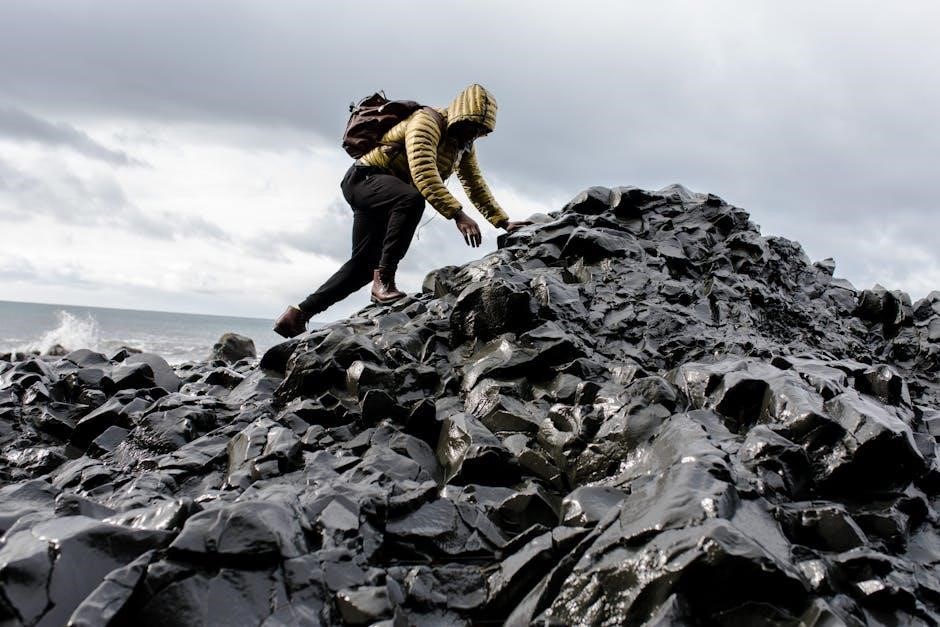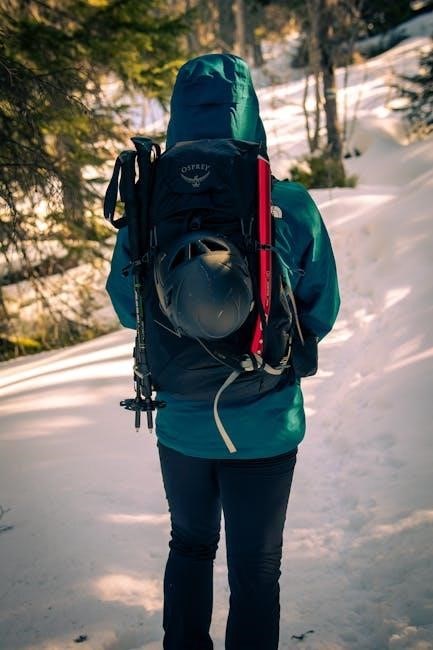Overview of Mt. Hood Guided Climbs
Mt. Hood guided climbs offer a thrilling adventure, popular for its glacier terrain and scenic views. Expert guides ensure safety and navigation, making the climb accessible to all skill levels, while the summit provides stunning vistas.
1.1 What is a Guided Climb on Mt. Hood?
A guided climb on Mt. Hood is an organized expedition led by experienced guides, offering a safe and structured ascent of the mountain. These climbs provide expert navigation, training, and support, catering to both novice and seasoned climbers. Guides handle logistics, route selection, and safety, ensuring participants can focus on the climbing experience while navigating glacier terrain and summiting successfully.
1.2 Why Choose a Guided Climb?
Choosing a guided climb on Mt. Hood ensures safety, expertise, and a memorable experience. Guides provide critical knowledge of routes, weather, and glacier conditions, minimizing risks. They also offer training and support, making the climb accessible to all skill levels. This approach allows climbers to focus on the adventure, knowing professionals are handling logistics and safety, enhancing overall enjoyment and success on the mountain.
Preparing for a Mt. Hood Guided Climb
Preparing for a Mt. Hood guided climb involves physical conditioning, understanding the climb’s demands, ensuring proper gear, checking weather conditions, and mental readiness for the adventure.
2.1 Physical Conditioning and Requirements
Physical conditioning is crucial for a Mt. Hood guided climb. Climbers need strong endurance, stamina, and muscular strength to handle the glacier terrain and heavy packs. Cardiovascular fitness is essential due to high altitudes. Participants should engage in regular aerobic exercises, strength training, and flexibility routines to build the necessary stamina. Proper physical preparation ensures a safer and more enjoyable climbing experience, allowing climbers to tackle the challenging conditions effectively.
2;2 Essential Gear and Equipment
Essential gear for a Mt. Hood guided climb includes crampons, ice axes, and sturdy mountaineering boots. Layers of breathable, waterproof clothing are crucial for varying temperatures. A helmet, rope, and harness are provided by guide services. Climbers should bring sunglasses, sunscreen, and trekking poles for stability. A backpack with snacks, water, and a first aid kit is also necessary. Proper equipment ensures safety and comfort during the ascent.

Cost of a Mt. Hood Guided Climb
The cost of a Mt. Hood guided climb typically ranges from $600 to $1,200 per person, depending on the climb’s duration, guide experience, and season. Prices cover essential services and equipment, ensuring a safe and guided experience.
3.1 Average Price Range for Guided Climbs
The average price range for a guided climb on Mt. Hood typically falls between $600 and $1,200 per person. This cost varies based on the climb’s duration, guide experience, and season. Longer climbs or those requiring more technical expertise may be pricier. The fee generally covers guide services, essential equipment, and safety measures, ensuring a well-organized and secure ascent up the mountain.
3.2 What’s Included in the Cost?
The cost of a guided Mt. Hood climb typically includes expert guide services, essential climbing gear, and safety equipment. Some packages may also cover food, accommodations, and transportation. Detailed briefings and pre-climb training are often provided to ensure preparedness. Additional expenses might include personal gear and gratuities, offering a comprehensive experience tailored to climbers’ needs for a successful and safe ascent.
Choosing the Right Guide Service
Selecting a reputable guide service is crucial for a safe and successful Mt. Hood climb. Ensure the service has certified guides, a strong safety record, and excellent reviews.
4.1 Qualifications and Experience of Guides
When selecting a guide service for Mt. Hood, prioritize guides with extensive experience and certifications. Look for guides certified by organizations like the American Mountain Guides Association (AMGA) or the International Federation of Mountain Guides Associations (IFMGA). These certifications ensure they possess advanced skills in glacier travel, crevasse rescue, and avalanche safety. Experience on Mt. Hood specifically is crucial, as familiarity with the mountain’s unique conditions enhances safety and decision-making.
4.2 Reputation and Reviews of Guide Services
Researching the reputation and reviews of guide services is essential for a safe and successful climb. Check online reviews from multiple sources, such as Google, Yelp, or guide service websites, to assess client satisfaction. Look for services with consistent positive feedback and a proven track record of successful climbs. Additionally, inquire about the service’s years of operation and their guides’ local knowledge, which can significantly enhance your experience. Ensure the service is transparent about safety protocols and success rates to build trust and confidence in your decision.

Popular Climbing Routes on Mt. Hood
Mt. Hood offers several renowned climbing routes, with the South Side being the most popular due to its accessibility and breathtaking views. Other routes provide varying challenges for different skill levels, attracting climbers worldwide.
5.1 South Side Route: The Most Popular Path
The South Side Route is the most popular path due to its accessibility and stunning views. It attracts climbers of all skill levels with its non-technical terrain, starting from Timberline Lodge at 5,900 feet. The route gains over 5,000 feet in elevation, offering breathtaking vistas of glaciers and surrounding landscapes. Early morning climbs are common to witness spectacular sunrises. Guided climbs are highly recommended for safety and navigation, especially for first-time climbers.
5.2 Other Routes for Experienced Climbers
Experienced climbers can explore routes like the West Crater Rim, Eliot Glacier, and Cooper Spur, offering technical challenges and breathtaking views. These routes demand advanced skills such as glacier travel and crevasse rescue. With steeper terrain and complex navigation, climbers must be prepared for physically demanding conditions. Guided climbs are still beneficial, providing expert navigation and safety. These routes reward climbers with stunning vistas and a true alpine experience.

Safety Considerations
Safety is paramount on Mt. Hood climbs, requiring proper gear, experienced guides, and awareness of hazards like crevasses, avalanches, and unpredictable weather conditions to ensure a secure ascent.
6.1 Common Hazards on Mt. Hood
Climbers on Mt. Hood face several hazards, including steep terrain, crevasses, serac collapses, and avalanches. Unpredictable weather conditions like whiteouts and high winds can disorient climbers, increasing risks. Proper training, equipment, and guidance are essential to navigate these dangers safely. Understanding glacier travel and self-arrest techniques is crucial for a secure ascent.
6.2 Emergency Procedures and Rescue Operations
In case of emergencies on Mt. Hood, climbers should stay calm and follow established protocols. Local rescue teams, such as the Mt. Hood Rescue Team, are highly trained to respond to incidents. Communication devices like two-way radios are essential for summoning help. Helicopter evacuations are often used for critical situations. Climbers should always carry emergency gear and know how to use it. Weather conditions can complicate rescue operations, emphasizing the importance of preparedness and guide expertise.
Best Time to Climb Mt. Hood
The best time to climb Mt. Hood is May to July, offering clear weather and stable snow conditions. Climbers enjoy ideal routes during this period with fewer crowds.
7.1 Climbing Seasons and Weather Conditions
Mt. Hood’s climbing season typically runs from May to September, with optimal conditions in June and July. Weather varies; clear skies and stable snow prevail in summer, while winter brings heavy snowfall and avalanche risks. Climbers must prepare for unpredictable conditions, including strong winds and sudden storms. Guides often recommend early morning starts to avoid afternoon clouds and ensure safe routes.
7.2 Avoiding Crowds and Optimal Timing
To avoid crowds on Mt. Hood, consider climbing during the midweek or early morning. Summer months see the most visitors, so plan your climb between April and May or September for fewer groups. Timing your ascent strategically can enhance safety, as afternoon snow soften and increase congestion. Booking guide services in advance ensures availability and avoids delays during peak season.

Training and Experience Required
Climbing Mt. Hood demands physical conditioning and glacier travel experience. Basic ice axe and crampon skills are essential, along with crevasse rescue knowledge for a safe ascent.
8.1 Basic Climbing Skills Needed
For a Mt. Hood guided climb, basic skills include ice axe techniques, crampon use, and rope work. Climbers should be comfortable with glacier travel and crevasse rescue basics. Physical fitness is crucial, as the climb involves steep terrain and high altitudes. Navigation skills and understanding of safety protocols are also essential. Guides often provide training, but prior experience with mountaineering equipment is beneficial for a smoother ascent.
8.2 Recommended Training Programs
To prepare for a Mt. Hood guided climb, consider enrolling in mountaineering courses that focus on crevasse rescue, ice axe techniques, and rope management. Endurance training, such as cardio and strength exercises, is also crucial. Many climbers benefit from programs like the American Mountain Guides Association (AMGA) certification or crevasse rescue workshops. These programs build confidence and skills, ensuring a safer and more successful climb.
Environmental and Ethical Considerations
Practicing Leave No Trace principles is essential on Mt. Hood. Climbers must minimize waste, avoid disturbing wildlife, and respect fragile alpine ecosystems to preserve natural beauty for future generations.
9.1 Leave No Trace Principles
Leave No Trace principles emphasize minimizing environmental impact during climbs. Climbers should pack out all waste, stay on designated trails, and avoid disturbing wildlife. Guided climbs often include education on these practices, ensuring that the pristine beauty of Mt. Hood is preserved for future generations to enjoy. Respect for nature is essential to maintaining the mountain’s ecosystems and biodiversity.
9.2 Respect for Wildlife and Ecosystems
Respecting Mt. Hood’s wildlife and ecosystems is crucial for climbers. Avoid disturbing flora and fauna, as the mountain is home to sensitive species. Keep noise levels low to avoid startling animals and stay on designated trails to prevent erosion. Never litter or remove plants, and be aware of protected areas. Guides often emphasize these practices to ensure climbers leave a minimal footprint, preserving the natural beauty and biodiversity of the region.

Overcoming Common Challenges
Mt. Hood guided climbs present challenges like altitude sickness and glacier terrain. Experienced guides help climbers navigate these obstacles, ensuring a safer and more successful ascent.
10.1 Dealing with Altitude Sickness
Altitude sickness, or acute mountain sickness (AMS), is common on Mt. Hood due to high elevation. Symptoms include headaches, nausea, and fatigue. To prevent AMS, climbers should ascend gradually, stay hydrated, and avoid overexertion. Guides monitor conditions and provide medical support if needed. Resting at lower elevations can help alleviate symptoms. Proper acclimatization and professional guidance are key to managing altitude-related challenges during the climb.
10.2 Navigating Glacier Terrain
Navigating Mt. Hood’s glacier terrain requires careful planning and expertise. Climbers must use crampons and ice axes to traverse icy surfaces safely. Guides often rope teams together to prevent falls into crevasses. Understanding glacier dynamics and using proper equipment is essential. Experience with glacier travel techniques, such as self-arrest and anchor placement, ensures a safer ascent. Professional guidance is crucial for negotiating these challenging and unpredictable conditions effectively.

Success Stories and Personal Accounts
Inspiring tales of climbers conquering Mt. Hood highlight determination and teamwork. Many first-time climbers achieve the summit with expert guidance, sharing stories of personal growth and breathtaking views.
11.1 Inspiring Tales of Successful Climbs
Climbers who have summited Mt. Hood share powerful stories of perseverance and triumph. Many recount overcoming physical and mental challenges, emphasizing the role of experienced guides in their success. These accounts often highlight the camaraderie and support within climbing teams, creating lifelong memories. The breathtaking views from the summit serve as a rewarding conclusion to their journeys, inspiring others to embark on similar adventures.
11.2 Lessons Learned from Experienced Climbers
Experienced climbers emphasize the importance of thorough preparation and mental resilience. They highlight the value of trusting guides and staying adaptable to changing conditions. Teamwork and clear communication are stressed as crucial for a successful climb. Many climbers also underscore the importance of patience and not underestimating the mountain. These insights provide valuable wisdom for those planning their own Mt. Hood adventure, fostering a safer and more rewarding experience.
Alternatives for Beginners
Beginners can explore shorter climbs or training programs near Mt. Hood, offering a gateway to build skills and confidence before tackling the summit with expert guidance.
12.1 Shorter Climbing Options
Shorter climbing options near Mt. Hood provide ideal training grounds for beginners. Routes like the Palmer Glacier or smaller peaks offer a chance to build essential skills and confidence. These climbs focus on glacier travel, crevasse rescue, and ice axe techniques without the physical demands of a full summit attempt. Guided tours ensure safety and learning, making them perfect for those preparing for more challenging climbs like the South Side Route.
12.2 Training Climbs Near Mt. Hood
Several training climbs near Mt. Hood offer excellent opportunities to refine skills. Areas like the Columbia River Gorge and smaller peaks provide ideal terrain for practicing glacier travel and crevasse rescue. These climbs allow climbers to build strength and confidence, essential for tackling the challenges of Mt. Hood. They serve as perfect preparation, ensuring climbers are well-equipped with the necessary techniques and physical conditioning for more demanding ascents.
Completing your Mt. Hood guided climb is a rewarding experience. Emphasizing safety, preparation, and guide expertise ensures success. Prepare well, embrace challenges, and enjoy the journey.
13.1 Final Tips for a Successful Mt. Hood Climb
To ensure a successful Mt. Hood guided climb, research thoroughly using specific keywords like “Mt. Hood climbing routes” or “best gear for glacier climbs.” Pack layers for unpredictable weather, and use trekking poles for stability. Stay hydrated and maintain a steady pace to conserve energy. Respect the environment by adhering to Leave No Trace principles. Lastly, trust your guides and embrace the journey for an unforgettable experience.
13.2 Encouragement for Future Climbers
Climbing Mt. Hood is a rewarding experience that offers breathtaking views and a sense of accomplishment. Don’t be intimidated—guided climbs are designed for all skill levels. Start with shorter training climbs and gradually build your confidence. Embrace the challenge, stay determined, and remember, the summit is within reach. Join the supportive climbing community and let the mountain inspire your next adventure!

